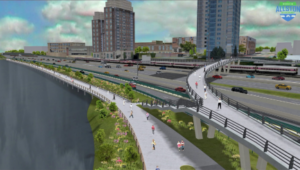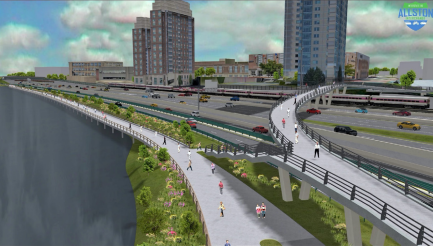Last week, the U.S. Department of Transportation announced $3.33 billion in grant funding for 132 projects. The revenue will flow from the Reconnecting Communities Pilot Program and the Neighborhood Access and Equity Program.
This funding is allocated for projects that reconnect communities that were cut off and/or divided by transportation infrastructure decades ago. It is earmarked for neighborhoods that lack direct access to schools, jobs, medical offices and places of worship. The projects are designed to stitch communities back together by capping highways to open access and add transit routes. Many projects will also include building sidewalks, bridges, bike lanes and trails – whatever is required to provide access to critical services. Forty-one states and Washington, D.C., will benefit from the funding, and the total allocation this year is 18 times larger than what was made available last year.
The large Allston Multimodal Project in Boston received a boost with the receipt of $335 million to support a $1.9 billion multi-modal project. The area around Interstate 90 on the Charles River waterfront in Allston will benefit from removing an elevated bridge structure that divides and cuts off multiple neighborhoods in the area. The project will remove the barrier and replace it with various transportation connections. A new multimodal transit station and more than 10 miles of new sidewalks and bike trails will be constructed. Approximately 40 acres will be reclaimed for open spaces and parks.
Construction will begin after all necessary permits are secured, but that will likely be sometime in late 2025. Project funding will come from several sources. City and state funds will be consolidated with federal funding and a partnership with Harvard University will also provide revenue.

Rendering of the Allston Multimodal Project. Photo courtesy of MASSDOT.
Earlier this month, the city of Atlanta received $157 million from programs that support efforts to connect communities. This allotment of revenue will support a civic infrastructure project designed to reunite downtown and midtown. The effort has a projected cost of $713 million, and when completed, this project will deliver a reimagined transportation plan for the core of the city.
Downtown and midtown were separated years ago by Interstates 75 and 85. The planned effort will create approximately 14 acres of urban greenspace atop a continuous bridge, or “cap,” that covers the Downtown Connector. The project will also create a quarter mile-long tunnel, which will be covered by a park and other transportation improvements. Other components include re-designing all roads in the area, rehabilitating the MARTA Civic Center station, and widening roadway shoulders and ramp upgrades to improve safety for drivers and pedestrians. City leaders are waiting for the design and engineering plans to be completed, and construction will begin after both are finalized.
Milwaukee received $36.6 million to rebuild the city’s 6th Street corridor that runs through downtown and nearby neighborhoods. When a roadway built in the 1960s separated several of Milwaukee’s communities and caused the future expansions of neighboring roads to cater to access ramps and accompanying traffic. The project is part of a recently approved plan that calls for reducing vehicle lanes, adding separated bike lanes and additional transit lanes and enhancing transit stops. The project will provide secure and separate amenities for pedestrians, cyclists and public transportation riders while incorporating eco-friendly infrastructure. The design phase will begin in the fall of 2024, and construction will be delayed until that is completed.
Officials at the Chicago Transit Authority received $111 million from the Reconnecting Communities Program to replace more than 10,000 feet of Blue Line tracks in East Garfield Park and West Garfield Park. The aged and soon-to-be-replaced tracks are currently designated as a “slow zone” because track conditions require trains to travel at a much slower speed. Replacing the tracks will improve the efficiency of the entire Blue Line and decrease travel time for passengers in underserved areas. Other improvements include increasing accessibility for all passengers and improving environmental resilience.
The effort related to replacing the track and adding signaling is part of a larger effort to rebuild the Blue Line’s Forest Park Branch, which was initially constructed in 1958. The design stage is underway, but construction could be delayed until 2027.
City officials in Knoxville, Tennessee, have announced plans to restore connections across barriers created by the construction of the James White Parkway in 1978. A federal grant of $42 million will support the initiative. That revenue will be consolidated with other funding to cover half the $85.6 million price tag for the effort. The project will be divided into phases, significantly expanding the city’s greenway system between the Old City and Knoxville Botanical Garden and Arboretum. It will add transportation pathways, including multi-modal paths for pedestrians and cyclists. Additionally, a “cultural corridor” will be created to connect 10 historical sites with educational amenities that exhibit and promote the history of the Black community in Knoxville.
The different phases of the project will operate on independent timelines depending on their readiness. Solicitation documents will be issued in 2024 and construction is planned to begin in 2025.
Funding for such projects is available now, but the programs have end dates. Local government leaders with projects that fit the stated qualifications for funding are advised to move quickly. Infrastructure projects abound throughout America and every state is eligible for funding support.







